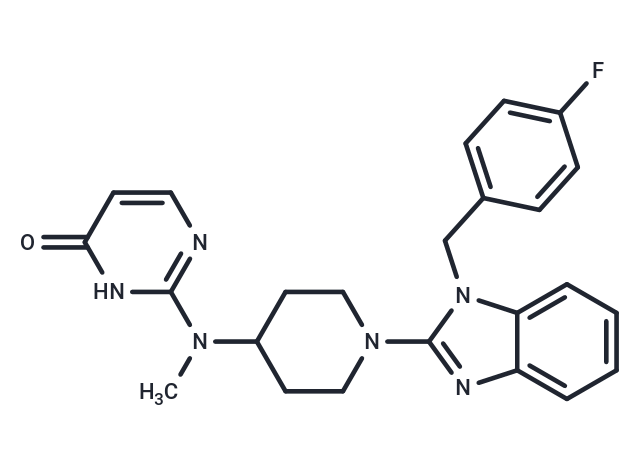Shopping Cart
- Remove All
 Your shopping cart is currently empty
Your shopping cart is currently empty

Mizolastine (SL 850324) (IC50= 47 nM) is a histamine H1-receptor antagonist.It is used in the treatment of allergic reactions such as hay fever (seasonal allergic rhinitis), hives.

| Pack Size | Price | Availability | Quantity |
|---|---|---|---|
| 10 mg | $35 | In Stock | |
| 25 mg | $53 | In Stock | |
| 50 mg | $68 | In Stock | |
| 100 mg | $97 | In Stock | |
| 200 mg | $187 | In Stock | |
| 500 mg | $313 | In Stock | |
| 1 mL x 10 mM (in DMSO) | $37 | In Stock |
| Description | Mizolastine (SL 850324) (IC50= 47 nM) is a histamine H1-receptor antagonist.It is used in the treatment of allergic reactions such as hay fever (seasonal allergic rhinitis), hives. |
| Targets&IC50 | H1 receptor:47 nM |
| Kinase Assay | ssay for cytokines: The cultures for cytokine production are set up at 37 °C as follows: the mixtures of SN-4 and autologous APC (each 1 × 105 cells/well) are cultured for 3 days with 50 μg/mL of Cry j1 in a total volume of 0.2 mL in round-bottomed micro plates; PBMC (2 × 10 5 cells/well) from normal donors are cultured for 24 hours with 10 μg/ml of PHA in a total volume of 0.2 mL in flat-bottomed, 96-well micro plates; and purified T cells (1 × 105 cells/well) from normal donors are cultured in a total volume of 1 ml for 24 hours with anti-CD3 mAb that have been immobilized on flat-bottomed, 24-well plates at a concentration of 5 μg/ml. Cytokines in the culture supernatants are quantitatively assayed by the following commercially available kits: IL-4 and IFN-γ. The sensitivity of the assay is 30 pg/mL for IL-4 and 1 U/mL for IFN-γ. |
| Alias | SL 850324 |
| Molecular Weight | 432.49 |
| Formula | C24H25FN6O |
| Cas No. | 108612-45-9 |
| Smiles | C(N1C(=NC=2C1=CC=CC2)N3CCC(N(C)C=4NC(=O)C=CN4)CC3)C5=CC=C(F)C=C5 |
| Relative Density. | 1.34g/cm3 |
| Storage | Powder: -20°C for 3 years | In solvent: -80°C for 1 year | Shipping with blue ice. | |||||||||||||||||||||||||
| Solubility Information | DMSO: 12 mg/mL (27.75 mM) | |||||||||||||||||||||||||
Solution Preparation Table | ||||||||||||||||||||||||||
DMSO
| ||||||||||||||||||||||||||

Copyright © 2015-2024 TargetMol Chemicals Inc. All Rights Reserved.